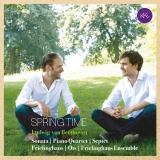Die beiden musikalischen Freunde Gustav Frielinghaus und Jaan Ots haben sich zusammen mit dem nach dem Geiger benannten Ensemble drei Werke des frühen Schaffens von Ludwig van Beethoven vorgenommen, um auch einmal die heiter-fröhliche Seite des Komponisten zeigen zu können.
Neben der schon im Titel Frühlingssonate anklingenden positiven Stimmung der genannten Jahreszeit sind dies das noch dem Vorbild Mozart verhaftete, wenn auch die Zukunft zart andeutende Klavierquartett und das solitäre Septett, beide in Es-Dur.
Die Interpretationen setzen zunächst mit handwerklich erlesen delikatem Spiel Marken, die man als maßstabsetzend sehen muss. Alles ist aufs Feinste ausgeleuchtet und gewichtet, so dass das Zuhören allein deswegen ein großer Genuss ist. Kleines Manko dieser Darstellung ist, dass es zeitweise nicht spontan genug erklingt. Das wirkt dann abgezirkelt ausgefeilt, aber eben nicht fröhlich ausgelassen. Aber da die Werke, wenn auch noch gemäßigt, den eigenen späteren Stil andeuten, hätte teilweise ein wenig mehr heroischer Zugriff gutgetan. Während die Sonate so zu entspannt erklingt, steigert sich die Intensität über das Quartett hin zum Septett. Bei letzterem gelingt die Balance ausgezeichnet. Hier wird das serenadenhaft Leichte so vordergründig platziert, dass das fast schon Strenge manch anderer Interpretation, die den düsteren Beethoven sucht, hier völlig verdrängt ist. In diesem Werk funktioniert der Ansatz grandios, bei der Sonate ist der Frühling noch in Knospen verschlossen, da wollen sich die Blüten noch nicht so recht öffnen.
The two musical friends Gustav Frielinghaus and Jaan Ots, together with the ensemble named after the violinist, play three works from Ludwig van Beethoven’s early oeuvre in order to be able to show the composer’s cheerful side. In addition to the positive mood of the aforementioned season, already alluded to in the title Spring Sonata, these are the Piano Quartet, still faithful to Mozart’s model, although delicately hinting at the future, and the solitary Septet, both in E-flat major.
The interpretations convince with exquisitely delicate playing that must be seen as setting standards. Everything is finely illuminated and weighted, so that listening is a great pleasure for that alone. A small shortcoming of this performance is that at times it does not sound spontaneous enough. It then comes across as circumspectly polished, but just not cheerfully exuberant. But since the works, though still moderate, hint at the composer’s own later style, a more heroic approach would have done well in places. While the Sonata sounds very relaxed, the intensity increases through the Quartet to the Septet. In the latter, the balance is excellent. Here the serenade-like lightness is placed so prominently that the almost austerity of some other interpretations, which seek the somber Beethoven, is completely eliminated. In this work, the interpretation is grandiosely efficient; in the Sonata, spring is still locked in buds, the blossoms don’t quite want to open yet.






















